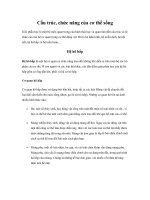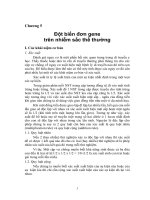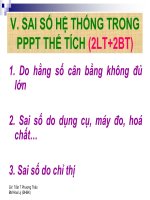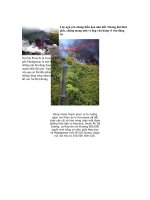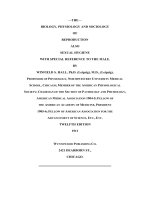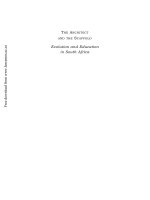The Architect and the Scaffold docx
Bạn đang xem bản rút gọn của tài liệu. Xem và tải ngay bản đầy đủ của tài liệu tại đây (477.87 KB, 171 trang )
THE ARCHITECT
AND THE SCAFFOLD
Evolution and Education
in South Africa
Free download from www.hsrc
p
ress.ac.za
Free download from www.hsrc
p
ress.ac.za
THE ARCHITECT
AND THE SCAFFOLD
Evolution and Education
in South Africa
Edited by
Wilmot James
Lynne Wilson
HUMAN SCIENCES
RESEARCH COUNCIL
NEW AFRICA
EDUCATION
Free download from www.hsrc
p
ress.ac.za
Compiled by the Social Cohesion and Integration Research Programme,
Human Sciences Research Council (Executive Director: Wilmot James)
Editors: Wilmot James and Lynne Wilson
Published by the Human Sciences Research Council Publishers
Private Bag X9182, Cape Town, 8000, South Africa
and
New Africa Education, an imprint of New Africa Books (Pty) Ltd
99 Garfield Road, Claremont, 7700, South Africa
© 2002 Human Sciences Research Council
First published 2002
All rights reserved. No part of this book may be reprinted or reproduced
or utilised in any form or by any electronic, mechanical, or other means,
including photocopying and recording, or in any information storage or
retrieval system, without permission in writing from the publishers.
ISBN 0-7969-2003-6
Produced by comPress
Distributed in South Africa by Blue Weaver Marketing and Distribution,
P.O. Box 30370, Tokai, Cape Town, South Africa, 7966. Tel/Fax: (021) 701-7302,
email:
Free download from www.hsrc
p
ress.ac.za
CONTENTS
Preface viii
Wilmot James
A Tribute to Stephen Jay Gould x
Pippa Skotnes
Introduction 1
Wilmot James and Lynne Wilson
SECTION 1
Science, Evolution and Schooling in South Africa 9
CHAPTER 1
Science, Evolution and Schooling in South Africa 10
Jeffrey Lever
CHAPTER 2
Comment and Response to Science, Evolution and Schooling
in South Africa 45
Wieland Gevers
C
HAPTER 3
Religion, Science and Evolution in South Africa:
The Politics and Construction of the Revised National
Curriculum Statement for Schools (Grades R–9) 51
Linda Chisholm
C
HAPTER 4
Science, Evolution, Religion and Education – Creating Opportunities
for Learning in South Africa’s Schools 60
Naledi Pandor
Contents
v
Free download from www.hsrc
p
ress.ac.za
CHAPTER 5
Alternative Sense-making Strategies – Can our Schools
handle the Challenge? 65
Bernard C. Lategan
SECTION 2
Evolution, Creationism, Indigenous Knowledge 73
CHAPTER 6
The Evolution/Creationism Debate: Insights and
Implications from the Indigenous Knowledge
Systems Perspective 74
Catherine Odora Hoppers
C
HAPTER 7
Islamic Discourse on Evolution: Response to Science,
Evolution and Schooling in South Africa by Jeffrey Lever 89
Abdulkader Tayob
CHAPTER 8
Evolution, Creationism, Indigenous Knowledge:
A Comment from a Somewhat Dissident Jewish Perspective 96
Denis Davis
C
HAPTER 9
Christianity and Evolution 100
David Chidester
SECTION 3
Biology, Evolution, Curriculum Development and Publishing 111
CHAPTER 10
The Structure of the Natural Sciences Learning Area Statement
and Opportunities within it for the Teaching and Learning
of Evolution 112
Dev Isaac
Contents
vi
Free download from www.hsrc
p
ress.ac.za
CHAPTER 11
Science, Evolution and Book Publishing: A Publisher’s Dilemma 121
Fathima Dada
C
HAPTER 12
Challenges of Writing about Evolution in School Textbooks 131
Colleen Dawson
SECTION 4
The Genome, Biology and Education 141
CHAPTER 13
Science, Genomics and Education in South Africa 142
Kader Asmal
About the Authors 152
Index 156
Contents
vii
Free download from www.hsrc
p
ress.ac.za
Preface
viii
PREFACE
The Colloquium on Science and Evolution in the Fullness of Life
held at Spier Estate’s Conference Centre on 8 June 2002 predictably
generated a great deal of debate in our newspapers. This is good
because the first step in advancing knowledge is to talk about the
issues, especially the controversial ones.
And evolution is probably the most controversial of all, for it cuts
deep into our common-sense understanding of who we are, where
we come from and where we are heading as an advanced species
populating and destroying, and as we create and live in this world.
Evolution is about understanding human nature; no wonder,
therefore, that it generates so much ‘heat.’
But the public debate illustrates also the challenges of public
understanding of science, human biology and evolutionary theory.
Indeed, there is no common vocabulary to discuss the issue
rationally; for example, scientists use the term ‘theory’ to refer to a
confirmed and coherently organised body of tested fact, while
your average citizens think theory is mere speculation.
This book intends to go beyond the limits of the public discourse
to give more depth to the challenges evolution poses to education
in South Africa. It seeks not only to fill the gaps in public
knowledge but also to provide a frame of reference by which we
can better understand the facts of everyday life. It is therefore part
of the architecture and scaffolding of knowledge about ourselves,
the nature of our family lives, religion and spirituality, art and
culture, sexuality, and even sports and politics.
We are grateful to all contributors to this volume, all of whom
save David Chidester, whose chapter was specially commissioned,
gave presentations at the Colloquium on Science and Evolution in
Free download from www.hsrc
p
ress.ac.za
the Fullness of Life. Gratitude also goes to Shell and the Swiss
Agency for Development and Co-operation (SDC) for making the
Colloquium possible.
The Architect and the Scaffold is dedicated to the late Stephen Jay
Gould, who made an extraordinary contribution to the public
understanding of human biology and evolution.
W
ILMOT JAMES
Executive Director
Social Cohesion and Integration Research Programme
Human Sciences Research Council
August 2002
Preface
ix
Free download from www.hsrc
p
ress.ac.za
x
A TRIBUTE TO STEPHEN JAY GOULD
Pippa Skotnes
My first encounter with Stephen Jay Gould was in the late 1970s
when I was a second year Archaeology student at the University of
Cape Town. It was an encounter characterised by a wonderful
academic generosity and a most extraordinary curiosity that
seemed prepared to find enlightenment in the most unlikely of
places. We had just had a series of lectures on the theories of
gradualism and punctuated equilibrium. I recall being highly
excited thereafter, and was delighted to identify, in an essay we had
to write on the merits of each theory, what I saw as a few flaws in
Gould’s thinking. I wrote to tell him this. To my surprise (though it
is even more surprising to me now, when I think back on this) he
wrote back, concerned to know exactly what my problems were
and asking me to keep in touch. I received a couple of postcards a
while after when he was travelling in Italy; he was still worrying
about the flaws, though by this stage I had realised that, as a
20-year-old Fine Art student with a passing interest in evolution,
I wasn’t going to able to hold up my end of the debate, and I steered
our correspondence into other areas.
Sometime later Steve contributed to a book I published on the
southern San. He loved the idea that the energies of a scientist
could lie side-by-side those of an artist on the pages of a book. He
also provided me with a number of reflections on various topics,
particularly when I was working on a project that examined, in
part, aspects of the history of scientific racism in South Africa. His
Mismeasure of Man had been a great influence on my own thinking
about the history of intelligence-testing and racism, as it has for
many others, not least of all in South Africa. It was guided by deep
A Tribute to Stephen Jay Gould
Free download from www.hsrc
p
ress.ac.za
compassion and a true understanding of the destructive effects of
negative stereotyping. Similarly, his work on the iconography of
evolution has been crucial in helping me understand just how
stereotypes are generated and systems of racism are justified. This
work of his has been central in providing ways of explaining
human diversity and underlining the dangers of equating
evolution with progress. Steve believed that evolution should be
taught in every classroom (uncontested by creationism or other
theories of origin) – an imperative made even more important in
South Africa, I believe, given our own troubled past and the
devastating effects of a belief in racial privilege. His legacy in this
area is profound.
Steve Gould had undoubtedly the most extraordinary and active
mind I have encountered. When I first met him, I recall standing, a
little overwhelmed, in his huge office – surrounded by hundreds of
cabinets with overflowing drawers and rows and rows of shelves of
books. His desk was bare, but for a photograph of himself with the
pope, and a 1920 Smith Corona typewriter on which he banged out
his essays, word perfect and without correction or second draft. He
talked incessantly and often at great speed. He had perfect recall of
almost everything he read and heard, and it was, at times, a
frustration for him that his speech could not keep up with the
stampede of thoughts and ideas that moved through his head. At
that time he was excited to show me a piece he’d just completed on
Leonardo’s Leicester Codex. ‘I’ve never spent so much time on an
article,’ he announced. ‘How long was that, Stephen?’ I asked. ‘Oh
all, of two weeks,’ he replied. ‘Two weeks!’ I gasped. He looked
apologetic – ‘Well,’ he said defensively, ‘it’s not easy to read
medieval Italian in a mirror!’
This year, 2002, provided a number of moments of closure for
Steve. His great tome on the structure of evolutionary theory was
published in March. When I saw him last it was almost complete,
and he was looking forward to the flurry of comment he knew it
would provoke. He had completed his run of essays for Natural
History and his final compilation was published shortly before his
death. And there was an end of sorts to the story of Saartjie
Baartman, whose skeleton was returned to South Africa in
July 2002 after much political wrangling. Steve had come upon
xi
Pippa Skotnes
Free download from www.hsrc
p
ress.ac.za
her remains in the Musee de l’Homme in Paris and his essay about
her had been responsible for resurrecting her from historical
obscurity and providing South Africans with an icon of colonial
humiliation.
Nevertheless his death was as untimely as it was unexpected.
There were new books he was working on, and an almost
implausibly diverse range of anecdotes still to be drawn into
discussions about science, evolution and history. He was an
extraordinary, often provocative, scientist, but it was this range,
this ability to capture the richness of human experience and bring
science and evolution to bear upon it, that made him also an
extraordinary human being and his death such a loss to scholars
and public alike.
A Tribute to Stephen Jay Gould
xii
Free download from www.hsrc
p
ress.ac.za
Introduction
1
INTRODUCTION
We live in exciting times. The 20th century saw humankind move
into an age of technology. We explored and mapped the surface of
our earth, the depths of our oceans and our immediate planetary
neighbours. But it was not until late in the century that we began
what is possibly the most challenging and relevant exploration of
all: the mapping of our own genome.
Our exploration of the building blocks of life has naturally led us
to question other aspects of our being: Why are we here? How did
we get here? In whose hands are we going to entrust the knowledge
of the most intimate details of ourselves?
Other questions also arose: When Africa is widely acknowledged
as the cradle of humankind, why was our continent marginalised
in the genome research? What were the ethical, moral and legal
implications of this research for a largely uninformed population?
The Africa Human Genome Initiative was founded to address
these concerns.
The human genome is actually more like a library than a map,
with a myriad books ready to be opened and read by generations
of scientists. The more we learn about the human genome, the
more we discover there is to explore. And the wider we prise open
this Pandora’s box, the more controversy and acrimony – especially
in the fields of science, evolution and religion – we release in the
process.
The story of genetics has been closely linked to education and
religion since it began.
Gregor Mendel, the ‘monk in the garden’, as his biographer
Robin Marantz Henig describes him in the title of her engaging
book, was an abbot and a teacher, as well as a gardener and a
Free download from www.hsrc
p
ress.ac.za
Introduction
2
fervent naturalist, whose curiosity and keen observation of pea
plants led to his discovery of the basic laws of heredity and the
beginnings of the modern science of genetics.
Mendel’s first paper was published in 1866, just seven years after
Charles Darwin’s seminal Origin of Species,
1
and although it did
not provoke the same fervour from its adherents or criticism from
its detractors, it was the first step on the road that has led, today, to
the unravelling of the web of life that is the human genome.
Mendel read Darwin’s theories with great interest, but his own
work was largely unrecognised in his lifetime, with the result that
Darwin was never aware of Mendel or his triumphant scientific
experimentation, although Darwin knew that the lack of an
explanation for heredity left a gap in his theory of natural selection.
Who knows what advances were lost because of the gap in
Darwin’s knowledge? And who knows what damage we could do to
our own children and the future scientific progress of our nation by
not providing full knowledge of some of the most relevant research
of our time?
The question of what is taught in South African schools is not a
simple one. Under the apartheid government and its Christian
National Education policy, evolution was given scant recognition
in the curriculum. Add to this the fact that there was a policy of
exclusion from science education for black learners, and the scale
of the problem of reforming our children’s science education
becomes apparent.
Jeffrey Lever sparked a debate in his paper Science, Evolution
and Schooling in South Africa,
2
republished in this book. His
comments issued a challenge to all involved in the educational
sector and demanded a response to the question of whether we
are giving the proper attention to evolutionary theory in our
schools.
As Bernard Lategan asks later in this book, ‘How should we
reform our school system and school curricula in the new South
Africa if we want to avoid the pitfalls of the past? Can we find a
1 Darwin, C. 1956 [1859], The Origin of Species. J.M. Dent: London.
2 Lever, J. 2002, Science, Evolution and Schooling in South Africa, Africa Human Genome Initiative:
Cape Town.
Free download from www.hsrc
p
ress.ac.za
Introduction
3
more constructive approach to the teaching of science and of
religion? Surely the main thrust of Lever’s argument is that the
South African school system – for whatever reason – has failed to
prepare students to deal with and to benefit from the insights of
contemporary science, specifically as far as the origin and
evolution of life is concerned.’
As the Human Genome Project opens the door to gene patenting
and bioethics, we are fully aware that an uneducated population is
a potentially exploited one. We cannot afford to sit back and allow
the genetic revolution to pass us by; we must tackle the issues that
arise from the research and we must be prepared to face and, if
necessary, allay the concerns of all the constituencies that are
affected by them.
In his paper commenting on and responding to Lever’s Science,
Evolution and Schooling in South Africa,
3
Wieland Gevers
postulates that the question should not be whether evolution is
taught in our schools, but rather what aspects of it are taught.
He argues that, even with the ‘gap between the brilliance of
scholars who can reduce the huge complexity of their fields of
enquiry to a simple, understandable level in books sold in up-
market bookshops, and the reality of thousands of classrooms filled
with restless teenagers conducting a personal ‘‘arms race” (not the
evolutionary kind) against their teachers, the syllabus and textbook
learning in general’, evolution is a subject that cannot be ignored.
He argues further that our children’s education should not stop
there; evolution should be used as a springboard to tackle issues
such as HIV and other ‘big issues of human life on earth’.
He throws down the gauntlet to pedagogical thinkers with his
contention that the major trends in evolutionary thought can be
accessible to the average adolescent, if presented in a relevant and
accessible manner.
Taking the concept a step further, Linda Chisholm assesses our
school textbooks in the light of the development of the curriculum.
The issue of what is taught, and how, is uppermost in her mind and
the minds of the authors of the Revised National Curriculum
3 Lever, J. 2002, Science, Evolution and Schooling in South Africa.
Free download from www.hsrc
p
ress.ac.za
Introduction
4
Statement. She and her colleagues are perhaps more aware than
most of the public response to evolution, and the challenges posed
by the ‘extremely unequal resources and conditions of schooling in
South Africa’. Her paper is a response to these questions; it lucidly
outlines the procedure of curriculum development, and the
challenging and unenviable task of trying to please all interest
groups. Ultimately, she says, ‘the curriculum was shaped by a
multiplicity of new, diffuse social forces, voices and educational
philosophies, much less visible and loud than the evangelicals, but
also far more powerful in the new South Africa’.
Naledi Pandor continues the story. She calls for a curriculum
that does more than focus on ‘previously excluded areas of study
and exciting new stories’. While she supports the call for evolution
to be taught in our schools, she is not convinced by Jeffrey Lever’s
assertion that ‘excluding evolution damages and limits learners
now’ and that ‘learners in the past have been damaged due to the
exclusion of evolution from the curriculum under apartheid’. In
fact, she warns, Lever’s position may do little more than ‘succeed in
reviving the largely silent Calvinist lobby of yesteryear, and provide
it with a large whipping stick for stirring up religious fervour and
furore in our schools’.
Rather than concentrating only on evolution, she says, we must
ensure that moral issues and norms are taught in tandem with the
scientific theories and advances which must form an integral part
of our children’s education. Both the useful and malign influences
of science need to be clear.
Pandor also inserts a caveat into the debate with her assertion
that Darwinian evolution has been used to ‘give support to
repugnant racial theories and racist movements’.
Catherine Odora Hoppers takes up the issue with her passionate
plea for the education of our children to go further than the debate
between ‘the evolutionist goats and the creationist sheep’.
Taking her position as a ‘radical witness and wounded healer’,
Odora Hoppers suggests that the battle lines are drawn not just
between evolutionists and creationists. She inserts another front
by adding imperialism and colonialism and the battle for the
hearts and minds of indigenous people. Indigenous knowledge
and traditional values have been eroded and belittled by the
Free download from www.hsrc
p
ress.ac.za
Introduction
5
‘mirror of western identity’. If we are changing our curriculum, she
argues, we should ensure that all the paradigms of our society are
equally represented.
Science, she also argues, is alienating in that it turns the individual
into an observer, a mere recorder of events. In addition, it panders to
the male obsessions of domination and control, while leaving Africa
a continent bereft of her virginity and robbed of her self-worth.
She issues a challenge to scientists and curriculum developers
alike to ‘help science recover its sense of dwelling, its sense of
caring, crying, laughter and joy’.
Abdulkader Tayob also bemoans the missing links in Lever’s
paper, albeit from a Muslim perspective. While the fundamentalist
Islamic view would find itself a bedfellow of the fundamentalist
Christian perspective in its rejection of evolution, Tayob furthers
the argument with his counterpoint Islamification of science:
‘According to this intellectual trend, Muslim scientists are called
upon to restructure modern sciences, social and natural, on the
basis of Islamic values’ – many private Islamic schools are
embracing this concept.
Echoing the views of Pandor, Muslims call for a religio-cultural
framework for science to provide a moral basis with which to
assess the clinical conclusions of scientific endeavour.
For Tayob, it is the gaps in Lever’s paper that beg more questions
than the paper itself: ‘The discussion is entirely restricted to white
educational experience of evolution and Darwin in South Africa.
The Islamic responses cited … are the only revelation that South
Africa has more than one educational tradition, and a minuscule
one at that. And even then, Muslim responses are presented as a
reflection of Christian fundamentalism.’
In addition, he takes Lever to task for his dogmatic assertion that
evolution ‘can unlock the secrets of the universe and of the human
condition itself’. In his own experience (we’re sure shared by many,
of whatever religious persuasion), evolution inspired an
understanding of biology but in no way shook his hold on the
Qu’ran as a central pillar of his life.
His paper serves as a warning against a monoculture of thought.
As he says, ‘The pluralistic history and experience of South Africa is
much too precious and rich to be obliterated with one framework.’
Free download from www.hsrc
p
ress.ac.za
Introduction
6
Continuing the religious debate, Denis Davis enters the fray
from what he describes as a ‘somewhat dissident Jewish
perspective’.
He takes us back to the beginning, building a case for under-
standing evolution within the first chapters of the Book of Genesis.
For Davis, the story of our evolution is hidden in the Hebrew words
chosen by the writer of Genesis. He explains the tradition of Jewish
mysticism which ‘viewed the world as continuously evolving
towards the goal of ultimate perfection’.
He issues a dire warning against the kind of fundamentalism
that asserts that ‘there is only one text, there is only one
interpretation, there is only one answer’, saying that it is this type
of thinking that threatens human freedom, democratic society and
the values prefigured in our constitution.
In spite of Davis’s appeal, the letters pages of our daily
newspapers at the time of the Colloquium indicated that the
schism between the evolutionists and the creationists seems
inevitable and unbridgeable. In his paper, David Chidester
attempts to open the debate by calling for the protagonists not to
accept or reject the proposition but rather to renegotiate the terms
in which that proposition is formulated.
As an example he draws on the history of Christianity in Africa,
where he says Africans accepted or rejected the appeal of the
Christian gospel and also renegotiated its religious terms. He sug-
gests that there is room for renegotiation of the terms under which
evolution is taught, but also observes rather wryly that ‘knowledge is
power’ and as such ‘is inevitably mixed up with political interests’.
So to the curriculum itself. Dev Isaac outlines the process of
developing a curriculum within the critical and developmental
outcomes and assessment criteria of the National Curriculum
Statement. Perhaps the most vital core of this whole debate can be
summed up in this statement: ‘The learner will be able to act
confidently on curiosity about natural phenomena, and to
investigate relationships and solve problems in scientific,
technological and environmental contexts.’
While Isaac tells us what should be done, Fathima Dada and
Colleen Dawson tell us how these aims can be translated into
actual lessons in the classrooms of our nation.
Free download from www.hsrc
p
ress.ac.za
Introduction
7
Dada tells us of the publishers’ dilemma: How does one
construct a text book which will remain fresh and relevant in a
rapidly changing and ever-expanding scientific environment?
Should creationism be taught as part of the religious education
curriculum, with evolution being taught in the Science class?
There is a hint of desperation in her tone as she is faced by Lever’s
claims that evolution is ‘uncontroverted’ and asks just ‘who claims
what is uncontroverted?’
She echoes the call of so many others in this book when she says,
‘The notion that the school curriculum should be a tool for propagat-
ing particular theories is a dated one. We should rather use the
opportunity to provide our children with the knowledge and skills to
analyse a variety of views and arguments, encouraging them to
engage in debate, analysis and the curiosity to seek more knowledge.’
How to nurture this creativity and curiosity is the particular
interest of Colleen Dawson, whose paper gives flesh to the bare
bones of curriculum and textbook. She takes us into the classrooms
and playgrounds and provides a glimpse of education that
challenges and stimulates young minds to reach their fullest
potential. As we discover more about the human genome, the
controversial subject of cloning has sparked much debate. After
reading Dawson’s paper, however, I’m sure there would be
widescale support for cloning a Ms Dawson for each of our schools.
If the designer Edwin Schlossberg will allow us a little poetic
licence with his statement on writing, perhaps the skill of curriculum
development is ‘to create a context in which other people can think’.
When we can do this, we will truly be offering our children an
education that lives up to its promise in the ‘fullness of life’.
Thanks are due to The Swiss Agency for Development and Co-
operation, and in particular Gerhard Pfister, without whose
generous support this book would not have been published. We
are also grateful to Shell for their support of the Colloquium at
which the papers were presented.
Editors
Wilmot James
Lynne Wilson
Cape Town, July 2002
Free download from www.hsrc
p
ress.ac.za
Free download from www.hsrc
p
ress.ac.za
SCIENCE, EVOLUTION AND
SCHOOLING IN SOUTH AFRICA
1
Free download from www.hsrc
p
ress.ac.za
Science, Evolution and Schooling in South Africa
10
SCIENCE, EVOLUTION AND SCHOOLING
IN SOUTH AFRICA
Jeffrey Lever
Introduction
The recent record reinforces the lesson of the years since 1858:
that Darwin’s account of evolution remains intact. Hereditable
variation and natural selection are indeed the agents that
shaped the present richness of life on Earth. The new genetics
does not challenge Darwinism but, on the contrary, is the
means by which the details of the course of evolution will be
unravelled from the sketchy fossil record and the growing
accumulation of data about the genetic constitution of animals
and plants.
1
In 1952 the curators of the Transvaal Museum in Pretoria exhibited
some of the findings of South Africa’s small band of palaeonto-
logists regarding the evolution of early humans in southern Africa.
It was an appropriate time. After more than 20 years of imperial
disdain towards the upstarts of colonial science, Raymond Dart
and his former colleague Robert Broom at the University of the
1 Maddox, J. 1998, What Remains to Be Discovered: Mapping the Secrets of the Universe, the Origins
of Life, and the Future of the Human Race, Macmillan: London.
Free download from www.hsrc
p
ress.ac.za
Witwatersrand were vindicated. With none other than that doyen
of British palaeontology, Sir Arthur Keith, in the lead, world
science had at last placed its stamp of approval on the hominid
status of Dart’s famous ‘Taungs Baby’, Australopithecus africanus.
2
It was in Africa that the human lineage had first evolved, not Asia,
as European and American scientists had previously believed.
Not everyone was pleased however. Representatives of the three
Dutch Reformed Churches contacted the Museum’s curators and
made clear their strong objections to the exhibition. The view of
the three Reformed Afrikaans Churches was that evolution was no
more than a hypothesis, and a far-fetched one at that. More to the
point, it was in conflict with the Bible, the early part of the Book of
Genesis in particular. Even scientists themselves, wrote the editor
of Die Kerkbode, (the official bulletin of the Nederduitse Gerefor-
meerde Kerk, by far the largest of the three Churches), disagreed on
evolution. The dominees made much of Robert Broom’s own
heterodox views on evolution.
3
‘We are grateful,’ wrote Die
Kerkbode’s editor, ‘that this matter has been raised once again by
our leaders of the church and trust that it will not happen again, as
so many times in the past, that the views of the Afrikaans Churches
on this issue will be ignored’.
4
This minor skirmish between the clerics and the scientists
occurred in the shadow of much larger events. Government
segregationists and Defiance Campaigners had bigger fish to fry
during 1952. But the pressure on the Museum curators was very
much part of a broader political tapestry, one being lowered over
the country in the name of a brand of Protestant Christianity that
commanded only a relatively small minority of the country’s
Christian believers. Among the many victims of Christian
National Education, Darwin’s theory of evolution by natural
selection was but one, and in social terms a relatively minor one,
offered up to the civil religion of ethnic nationalism during the
Jeffrey Lever
11
2 Dart, R. 1959, Adventures with the Missing Link, Hamish Hamilton: London, Chapter Seven.
3 Broom, like Arthur Russel Wallace, co-founder with Darwin of the theory of evolution by natural
selection, considered that there had been some ‘spiritual agency’ at work in the evolution of
humankind. See for example Wells, L.H., 1967, ‘One Hundred Years: Robert Broom 30 November
1866 – 6 April 1951’. Robert Broom Memorial Lecture. South African Journal of Science, vol. 63,
September, p.362.
4 Die Kerkbode, 1949–1952, 24 September 1952.
Free download from www.hsrc
p
ress.ac.za
course of the 1950s. But it is one whose spectre is only now, very
gingerly it would seem, being laid to rest more than 50 years later
in the nation’s schools.
Evolution and Science at the Inception of the 21st
Century
Over the last 150 years modern science has assembled a remark-
ably coherent picture of our universe and humanity’s place within
it. We now can give evidence-based answers to the questions that
humans have posed since the dawn of consciousness. What is this
reality all around us? What is this starry firmament that shines
down on us here when we care to look up? Where did it come
from? How did life arise and with it the human being?
5
How
indeed is there anyone at all out there looking into the night, and
asking these questions?
These issues are of more than metaphysical interest. The
scientific revolution of the last 200 years has proceeded hand-in-
hand with technological advance. The culminating scientific
achievement brought about by 20th century science, the unravel-
ling of the human genome in mid-2000, could only take place due
to the developments in computation that began a mere 50 years
ago. Without the high-powered computers that derive from the
intellectual breakthroughs in mathematics in the 1930s, the task of
sequencing the 3.2 billion base pairs of our common human
genome would have been unthinkable. The connection runs
deeper. The binary maths of the computer programme is uncan-
nily paralleled by the linear digital code of the DNA sequence. Thus
basic science and technology advance in tandem. Our technology
rests on our understanding of the scientific fundamentals that are
derived from the overarching theories brought to fruition in the
20th century. The technology in turn deepens our theoretical pro-
gress in a continual feedback loop.
At the beginning of the 21st century, then, our scientific
synthesis regarding many of the most salient features of our exter-
Science, Evolution and Schooling in South Africa
12
5 For a review of current notions on the origin of life, and indeed on the other major frontiers of
contemporary science, see the book by the former editor of Nature. Maddox, J. 1998, What Remains
to be Discovered: Mapping the Secrets of the Universe, the Origins of Life, and the Future of the
Human Race, Macmillan: London.
Free download from www.hsrc
p
ress.ac.za
nal reality hangs together as never before. There is a consistent
narrative to be told about our cosmic beginnings, our middle
passage through star and galactic formation, and the ultimate
genesis of life on earth, whether in some ‘warm little pond’ as
Darwin hypothesised, or elsewhere. The story is far from complete.
Parts of it may be altogether mistaken. A new twist in one part may
cause ripples that reconfigure even the fundamentals of the
current picture – just as Max Planck’s small step towards the idea of
a quantum of energy was to upset the whole of a seemingly
finished physical science at the beginning of the last century.
But let us not underestimate the achievements of the 20th
century scientific endeavour. It has abolished once and for all the
mechanistic determinism that Newtonian physics seemed to
install in the universe. Materialism as a doctrine now rests on
shaky foundations when we probe the inner recesses of matter.
The universe has changed its character from one of infinite space
existing in eternal time to a space-time bounded explosion of
potential that brings back to mind the discredited metaphysics of
G.W.F. Hegel. The debate over the precise implications of quantum
mechanics for our ontology still rages. Here in the paradoxical
interplay of wave and particle, in the mysterious non-local
entanglement of far distant particles, can still be found some room
for theological and metaphysical musings. Not that most scientists
themselves are inclined to see in all this any reason for a new
supernaturalism or deism.
6
Yet things are definitely more interest-
ing than when a clock-work universe seemed the appropriate
cosmic model.
Strangely it is the most accessible, least quantified theory of
19th century science that has best stood the test of time. Anyone
can read The Origin of Species and get the gist of the message.
Darwin’s theory of evolution by way of natural selection has been
elaborated, refined, and combed over for possible flaws, but it still
stands stubbornly uncontroverted. Its power has seemed to dim
several times over the past 140 years, but each time it has returned,
more compelling than before in its stark logic.
Jeffrey Lever
13
6 Nobel Prize-winning physicist Steven Weinberg made the famous comment that still resonates in the
debate: ‘The more the universe seems comprehensible, the more it seems pointless.’ (Weinberg, S.
1993, Dreams of a Final Theory. Hutchinson Radius: London.
Free download from www.hsrc
p
ress.ac.za

